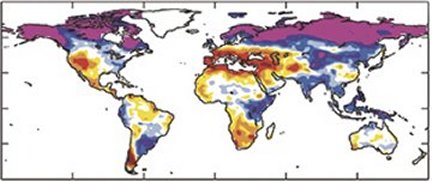In the next half century, rivers and streams in some parts of the world will diminish in flow, while waterways elsewhere rise in output, according to a new analysis of climate simulations.

Drying could contribute to droughts and wildfires, for example, in the western United States. Eastern North America and other increasingly wet regions may face excess floods, says hydrologist Christopher Milly of the U.S. Geological Survey in Princeton, N.J.
In a separate study, researchers led by Tim P. Barnett of the Scripps Institution of Oceanography in La Jolla, Calif., predict that global warming will reduce seasonal water availability for about 1 billion people.
The two groups’ studies appear in the Nov. 17 Nature.
Milly’s team began with 21 computer models of the world’s climate. Each model calculates interactions among greenhouse gases, circulating air masses, sea-surface temperatures, and other climatic variables.
For 165 sites around the world, the researchers tested how well each model calculated changes in stream flow during the 20th century from historical data on greenhouse gases. Then, the team compared projections of stream flows through 2050 from the 12 most accurate models.
Most of these models agree that average water flow will decrease in the western United States, the Mediterranean region, the Middle East, and southern Africa. Flow increases appear likely in East Africa, central and Southeast Asia, and the northern latitudes of Eurasia and North America, including the eastern United States.
Kevin Trenberth, an atmospheric scientist at the National Center for Atmospheric Research in Boulder, Colo., cautions that the new study’s predictions will be more accurate for larger areas than for specific countries. He’s also skeptical about the wetness predicted for temperate areas.
“The models look like they’re behaving better in the tropics than in the midlatitudes,” agrees hydrologist Randal D. Koster of NASA’s Goddard Space Flight Center in Greenbelt, Md.
But both he and Trenberth say that the study highlights a worrisome global pattern.
“Areas that are already wet are likely to get wetter,” Trenberth says. “Areas that are already water stressed are likely to feel it more in the future.”
Regional drying could be compounded by rising temperatures in snow-covered mountains and snowmelt-fed river valleys, Barnett says. He and his colleagues identified areas worldwide where snowmelt is an important contributor to summer and autumn stream flows and where dams and reservoirs are insufficient to store water that runs off prematurely. One-sixth of the world’s population lives in such regions, the researchers conclude.
Barnett says that global warming will turn some winter precipitation to rainfall and cause earlier snowmelt, reducing runoff later in the year, when it’s needed for uses such as agriculture.
“Some regions are going to really get hammered, the western U.S. being one of them,” he says. Building more dams and using seasonal water surpluses to refill depleted aquifers could minimize annual shortages.
Nevertheless, comments ecologist Steven Running of the University of Montana in Missoula, Milly’s results suggest that perpetual low-intensity droughts could become the norm in some semiarid regions, creating “a downward spiral of the ecosystem.”






